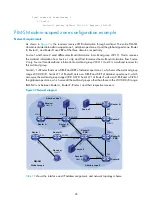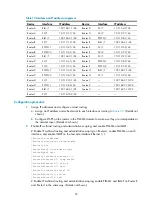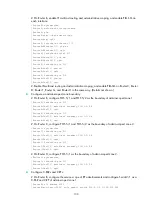
85
Configuring hello options globally
Step
Command
Remarks
1.
Enter system view.
system-view
N/A
2.
Enter public network PIM view
or VPN instance PIM view.
pim
[
vpn-instance
vpn-instance-name
]
N/A
3.
Set the DR priority.
hello-option dr-priority
priority
Optional.
1 by default.
4.
Set the neighbor lifetime.
hello-option holdtime
interval
Optional.
105 seconds by default.
5.
Set the prune message delay.
hello-option lan-delay
interval
Optional.
500 milliseconds by default.
6.
Set the override interval.
hello-option override-interval
interval
Optional.
2500 milliseconds by default.
7.
Enable the neighbor tracking
function.
hello-option neighbor-tracking
Disabled by default.
Configuring hello options on an interface
Step
Command
Remarks
1.
Enter system view.
system-view
N/A
2.
Enter interface view.
interface
interface-type
interface-number
N/A
3.
Set the DR priority.
pim hello-option dr-priority
priority
Optional.
1 by default.
4.
Set the neighbor lifetime.
pim hello-option holdtime
interval
Optional.
105 seconds by default.
5.
Set the prune message delay.
pim hello-option lan-delay
interval
Optional.
500 milliseconds by default.
6.
Set the override interval.
pim hello-option override-interval
interval
Optional.
2500 milliseconds by default.
7.
Enable the neighbor tracking
function.
pim hello-option neighbor-tracking
Disabled by default.
8.
Enable dropping hello
messages without the
Generation ID option.
pim require-genid
By default, an interface accepts
hello message without the
Generation ID option.
Setting the prune delay timer
The prune delay timer on an upstream router on a shared-media network can make the upstream router
not perform the prune action immediately after it receives the prune message from its downstream router.
Instead, the upstream router maintains the current forwarding state for a period of time that the prune
delay timer defines. In this period, if the upstream router receives a join message from the downstream
router, it cancels the prune action. Otherwise, it performs the prune action.






























